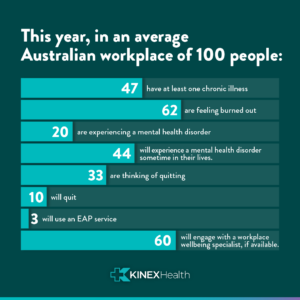Read time: 5 minutes 45 seconds
According to the stats, workers are struggling and our management strategies aren’t hitting the mark.

In a typical workplace of 100 people, if everything is bang on average, we’re seeing quite a few health and wellbeing issues across the board.
Almost half the staff are experiencing a chronic illness, 20 are experiencing a mental disorder (many of which overlap with chronic illnesses), and a whopping 62 of them are feeling burned out.
If that wasn’t enough, 33 are thinking about quitting and 10 of them actually will.
Despite this, only 3 of them (yes, 3) will call an EAP service this year for assistance.
Just looking at the numbers, this shows us that our current management strategies aren’t doing the job.
Many workplaces will look at these figures and think, ‘That’s not our people. Our people are doing fine’, but chances are, that’s just not the case.
There are far more people struggling with mental and physical health and wellbeing ailments than will ever disclose them, which means even these averages are probably below the actual figures.
There’s a debate raging amongst workplaces and their workers over who bears the responsibility for managing health and wellbeing.
Is it up to the worker to sort it out and take care of themselves?
Or is it the responsibility of the workplace to provide the resources and allowances for workers to be healthy and well?
Like most things, the answer lies somewhere in the middle (as much as we often don’t like to admit that because what we think is more right, right?) but there is a caveat.
Whether providing for good health and wellbeing is the responsibility of the workplace or not, the impacts of poor health and wellbeing are the workplace’s problem.
We know from the data that people who are healthy and well perform better, take less sick leave, don’t file worker’s compensation claims and rarely burn out, when compared to people who are unhealthy and/or unwell.
This means that managing health and wellbeing shifts from just being the right thing to do into a strategic imperative for businesses.
The issue is that the way most businesses are managing it isn’t working.
In particular, EAP programs that only see between 2-4% of workers are not making a dent and one-off initiatives aren’t seeing the lasting impact that’s needed.
Over the years, what we’ve seen work best are initiatives that recognise the shared responsibility between worker and workplace and seek to enhance both, not minimise one in favour of the other.
The way this works is straightforward, if not always simple.
On one hand, businesses should seek to upskill their workers in health and wellbeing so that they have the knowledge and skills to be healthy and well under any circumstances, even when those circumstances are not ideal.
And on the other, they should look to improve those circumstances to make it easier for workers to be healthy and well.
This bridges the gap between workers and workplaces and gives them a shared responsibility, a common goal that they can work towards together, rather than pointing fingers and only hurting themselves and each other in the process.
This is exactly what workplace wellbeing specialists do and why they’re so valuable.
If you’re thinking that this is a promotional piece for workplace wellbeing specialists (because that’s what we do) then you’re damn right.
I’ve spent many years in workplace wellbeing and these specialists are far and away the single greatest intervention there is.
If something else worked better, that’s what we would do.
It’s what I recommend to every workplace and what will eventually put an end to the ever-increasing health and wellbeing issues we’re seeing eat away at the quality of our lives and businesses.
Whether you’re ready for a workplace wellbeing specialist or not, the issue remains that our people are struggling and they need some help, so whatever you do, don’t put your head in the sand on this one, because that’s how we all lose.
For more info on this check out pretty much any of our stuff on LinkedIn or send me an email at [email protected] and let’s have a chat.
Question
How are you planning to address the health and wellbeing issues amongst your people?







